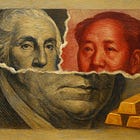China Speaks in Gold Now
And the West still hasn’t learned to translate it.
Gold hit $4,370 per ounce in October 2025. Up fifty percent on the year. A message.
China has been waging financial warfare in plain sight, and most of the West still hasn’t noticed.
The People’s Bank of China just finished an eleventh straight month of buying.
Official reserves: 2,298.53 tonnes. Sixth in the world. Sounds large until stacked against $3.2 trillion in foreign exchange reserves. That’s roughly 7% in gold. Europe sits north of 60% for several countries. The global central bank average is about 15%.
Call China underweight, or call it misdirection.
Unless the books aren’t telling the full story.
The Shanghai Gold Exchange is the world’s busiest physical market. In Q3 2025, withdrawals ran 297 tonnes. The PBoC admitted to 5 tonnes that same quarter.
The rest did not evaporate.
From 2009 to 2015, Beijing quietly amassed more than 600 tonnes off the radar, then announced a neat step-up all at once. Surprise, but not really.
Conservative reads now peg China near 4,300 tonnes. Aggressive takes run to 8,000. The high-end crowd whispers 15,000. If the midpoint is even close, that’s over a trillion dollars in metal that cannot be sanctioned or switched off.
Maybe this is prudence. Diversify, hedge, de-risk. Plenty of countries are doing it. Turkey, Poland, India. Central bank buying has topped a thousand tonnes a year for several years running.
Here’s the rub.
Gold’s share of central bank reserves overtook Treasuries in 2024-2025 for the first time in decades. China trimmed Treasuries to roughly $775 billion by July 2025, behind Japan and the UK.
Buying accelerated after the tariff shock in April 2025. Prices ripped higher. Purchases continued anyway.
Gold has one trait no other reserve asset can match. No counterparty. Dollars can be frozen. Bonds can be coerced. Banking pipes can be shut. Bars in a Beijing vault cannot be canceled by memo.
Russia’s 2022 freeze-up taught that lesson in 72 hours.
Inside China, households have been sprinting toward metal. The Shanghai benchmark set record after record this year. Investment demand in bars and coins punched to an 11-year high in 2024. Real estate slumps, the currency drifts, and people do what people do when trust thins. They reach for what feels real.
Here’s the weird twist.
Despite the frenzy, domestic prices often traded at a discount to global benchmarks in 2025. Sometimes $71 per ounce. Beijing juiced equities with a CSI300 rally, nudging retail cash back into stocks, cooling the gold fever, smoothing the state’s own accumulation.
Market management with training wheels, and it worked.
Picture the system in three layers. Top: the PBoC soaks up metal. Middle: the SGE channels flow and sets the tempo. Bottom: retail is steered by policy nudges and sentiment.
Net result: steady inflow into state hands without a siren blaring on Wall Street screens.
The larger project is not a mystery. A digital yuan is being built, piece by piece. No formal promise of gold backing, yet the architecture could support it. For countries that feel boxed in by the dollar order, a politically neutral reserve payment rail has obvious appeal.
This is not about next week. Not about next quarter.
Give it a decade. Stockpiles large enough to anchor credibility. Payment rails that skip New York. Bilateral trade that settles outside the dollar. A cohort of emerging markets that want options and finally have one.
Dismissing this as conspiracy requires willful blindness. The buying is public. The exchange is massive and out in the open. The digital plumbing is being laid in broad daylight.
The only real conspiracy is pretending it’s normal portfolio rotation.
The dollar isn’t going to collapse overnight. Hegemonic currencies don’t work that way. But the foundation is cracking.
China understands the stakes. Russia understands them. Turkey and Poland certainly act like they do. India, too.
The question is simple. Will Washington treat this as a strategic challenge or as another think-tank panel?
The goal is not to crash the dollar by Tuesday. The goal is to make the dollar optional within a reasonable horizon, and the buying pattern telegraphs that intention.



